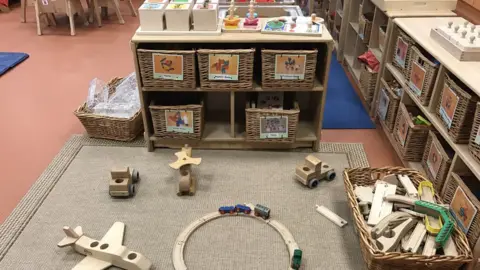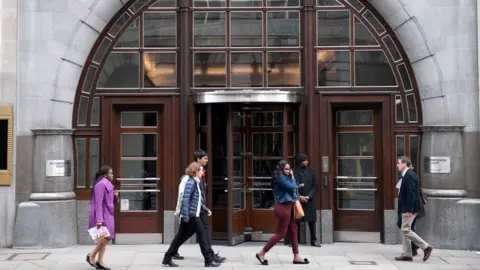A glimpse inside the Goldman Sachs nursery
 Amanda Wong
Amanda WongHead into the Goldman Sachs building on London's Fleet Street and you're greeted by wall to wall marble, a bank of receptionists and a water feature. So far, so City.
But wind your way past the lifts through an anonymous fire door and you enter a world that couldn't be less corporate. The sounds, colours and laughter of a nursery.
The Goldman Sachs Children's Centre is both incongruous - and an anomaly - the only onsite childcare facility in the Square Mile. Started in 2003 to offer back up provision for staff, it takes kids between the ages of three months and 12 years old.
The expense and regulatory requirements for such a facility are the main reasons why it is unique - and peculiar to a bank with deep pockets.

This is part of a day of BBC coverage looking at the cost of holiday childcare. Find out more at bbc.co.uk/business or follow the conversation on social media using the hashtag #Childcare

According to the latest figures from the Chartered Institute of Personnel and Development, only 5% of businesses in the UK now offer childcare in the workplace.
Anecdotally, this is almost exclusively made up of large employers because they have the money and space to allow for it. They include government departments, Royal Mail, a variety of universities, Microsoft and Toyota.
There are tax breaks for those companies that do.
 Goldman Sachs
Goldman SachsEmployers who include childcare as part of the employee remuneration package, attract tax, National Insurance and reporting obligations.
However, employers that offer in-workplace nurseries don't - and they get relief for the day-to-day running and capital costs of providing the service, for example heating and lighting, and premises.
Flexible work
It might be seen as a perk now, but onsite childcare flourished in the immediate post-war years out of necessity.
A labour shortage meant that women were needed to work - and factories and mills started to offer the creches that allowed them to.
Dr Laura Paterson of Oxford University, who specialises in the history of women's employment, says that childcare provision by businesses died away in the 1950s as the need for women became less acute and the way they worked changed.
"Part-time and flexible working hours reduced the need for workplace nurseries to some extent," she says,
"Women who worked from the 1950s to the 70s tell us that they did part-time jobs when their children were young to fit around school hours. And they worked in the evening so that their partner could care for their children."
 Goldman Sachs
Goldman SachsBut what about those working full-time at Goldman? For Amanda Wong, who project manages new trades for the firm and is a mum to 12-month-old Naomi, the children's centre has been a lifesaver.
Ms Wong put her daughter into nursery the same day she returned to work, shortly after Naomi turned nine months.
"It has made me feel a lot more relaxed and mentally ready to come back to work a lot earlier than I would have and I think it helps new mums with separation guilt or anxieties about returning to work," she says.
Though she admits it's not ideal to take a one-year-old on the Tube through central London each day.
Ishmeet Rayit, who manages the Goldman Sachs Children's Centre, tells me they have a higher staff ratio than Ofsted regulations require (one-to-two in the baby room rather than one-to-three), because they need to make children who might not be familiar with them, settle in quickly.
Of the 5,500 people who work in the office, about a quarter are registered users. Each parent at the bank gets 20 free "back-up" days to use the centre, renewed each year.
The most coveted facility in the centre is the after-school and holiday programme where the 5-12 year olds come. It's stuffed full of bilingual books and toys, showing just how multicultural the bank is.
"The kids call it an office day," Ms Rayit says. "They get taken out for lunch by their parents and they make friends here." Parents are only allowed to book 10 days of this holiday service at a time, the room can accommodate 12, and the waiting list to get in is long.
 Getty Images
Getty ImagesSally Boyle, the international head of human resources at Goldman, says it is a "significant cost" to the firm - but it is worth it.
"We've definitely seen it have an impact on retention of a smallish group of women but important women who wouldn't have stayed I suspect if they hadn't been able to manage that childcare in a way that they can here," she says.
The centre is run by Bright Horizons, the largest provider of workplace nurseries in the UK. Goldman pays it a monthly management fee, and parents who need childcare beyond that paid for by the bank, deal directly with the nursery.
A spokesperson for the company says that demand for onsite care is increasing. "In today's competitive talent market, recruiting and retaining exceptional people is a high priority for organisations.
"Onsite childcare has been identified as a key factor in encouraging parents to return to work and, in turn, helping organisations to thrive".
'Chronic shortage'
But Rohan Silva, whose Second Home drop-in work spaces are planning in-house creches, says the barriers to entry today of setting up onsite childcare are enormous.
"The Ofsted accreditation process takes at least three months, and costs hundreds of pounds in registration costs and consultancy fees. In addition, there are multiple additional inspections each year, plus a chronic shortage of trained staff," he says.
 Second Home
Second Home"Another challenge is the fact that so few architects and designers have ever designed childcare facilities, because so few are created by property developers. That means thinking from scratch the issues around access and child-friendly materials," Mr Silva says.
He believes it's a vital way of allowing more parents to work. "The UK's rate of maternal employment is 27% lower than other Western countries - making childcare more accessible will make a big difference.
"This is especially true of single parents - who are much more likely to be unemployed, and for whom access to childcare is the biggest barrier to finding work," Mr Silva adds.
A recent Institute of Directors survey backs this up. It found over half of its members think that the cost of childcare hurts careers - particularly those of women.
It is currently consulting on whether to open a creche for its members.
For now, though unlike those women working in factories after the war, the option of taking your child to work is offered at a company's largesse rather than out of compulsion. And it's reserved for a privileged few.

